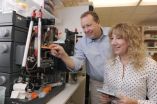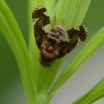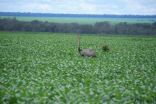(Press-News.org) Researchers have found that the budding yeast (Saccharomyces cerevisiae) is an acceptable model system to study KP1019, an anti-cancer drug that uses ruthenium, a rare metal, a new study found. Researchers had previously been interested in studying KP1019 because it is believed to cause cancer cell death and is not known to have negative secondary side effects for healthy tissues.
"We wanted to learn more about how KP1019 works on a cellular level, and how the drug acts on yeast cells can be indicative of how it will perform on mammalian cells," said Pamela Hanson, associate professor of biology at Birmingham-Southern College in Alabama. "Besides the economic advantages, there are good scientific reasons to work with yeast, including the abundance of yeast genetic and genomic tools."
In past research, KP1019 has been shown to inhibit ovarian tumor cell production, cause death of colon cancer cells and reduce overall tumor size.
Along with testing the hypothesis that yeast could be a good model system for studying KP1019, researchers wanted to identify how the drug was internalized by cells. KP1019 was taken up within two hours and caused a dose-dependent increase in cell death. It was also found to delay cell proliferation within one hour, most likely the result of KP1019 binding to and damaging DNA.
"More research needs to be done on how KP1019 is internalized," said Hanson. "We suspect that the drug enters cells through more than one route."
Previous studies showed that this drug entered cancer cells, at least in part, through the transferrin-mediated iron-uptake pathway; however, yeast does not contain this specific pathway. Therefore, there must be other means for this drug to enter cells.
###The findings will appear in the January edition of the journal Molecular Pharmacology. KP1019 is currently in clinical trials.
Researchers find model system to study promising cancer drug
2012-12-18
ELSE PRESS RELEASES FROM THIS DATE:
Chronic worriers at higher risk for PTSD
2012-12-18
EAST LANSING, Mich. --- People who worry constantly are at greater risk for post-traumatic stress disorder, according to new Michigan State University research published in the journal Psychological Medicine.
Many people experience traumatic events such as the death of a loved one, being assaulted or witnessing violence, but only a small minority develop PTSD, said study author Naomi Breslau, a professor of epidemiology at MSU.
"So the question is, 'What's the difference between those who develop PTSD and the majority who don't,'" Breslau said. "This paper says people ...
Hybrid tunnel may help guide severed nerves back to health
2012-12-18
UNIVERSITY PARK, Pa. -- Building a tunnel made up of both hard and soft materials to guide the reconnection of severed nerve endings may be the first step toward helping patients who have suffered extensive nerve trauma regain feeling and movement, according to a team of biomedical engineers.
"Nerve injury in both central nervous system and peripheral nervous system is a major health problem," said Mohammad Reza Abidian, assistant professor of biomedical engineering, Penn State. "According to the National Spinal Cord Injury Statistical Center, there are approximately ...
Researchers identify role for protein linked to obesity, type 2 diabetes
2012-12-18
DALLAS – Dec. 17, 2012 – Researchers at UT Southwestern Medical Center have taken another step toward better understanding the metabolic functions of obesity and its connection to type 2 diabetes.
Dr. Philipp Scherer, Director of the Touchstone Center for Diabetes Research at UT Southwestern, led a group of researchers in a recent multicenter study published in Nature Medicine that successfully identified ways to manipulate the protein mitoNEET. This is the first time the protein has been effectively altered to expand fat tissue in a way that allows subjects – in this ...
EARTH: Antarctic meteorite hunters
2012-12-18
Alexandria, VA – For more than 35 years, scientists from the Antarctic Search for Meteorites (ANSMET) program have been scouring glacial landscapes in search of meteorites. Since 1976, teams of physicists, meteorite specialists, and mountaineers have recovered thousands of untouched specimens from meteoroids, the moon and even Mars. Despite subzero temperatures and razor-sharp winds, scientists are lining up for the chance to experience the ultimate hunt for alien objects in the alien environment.
ANSMET teams either conduct systematic searches of a region or work as ...
Plant sniffs out danger to prepare defenses against pesky insect
2012-12-18
UNIVERSITY PARK, Pa. -- A plant may start to prime its defenses as soon as it gets a whiff of a male fly searching for a mate, according to Penn State entomologists.
Once tall goldenrod plants smell a sex attractant emitted by true fruit fly males, they appear to prepare chemical defenses that make them less appealing to female flies that could damage the plants by depositing eggs on them, the researchers said.
"It's become increasingly clear in recent years that plants are responsive to odors," said Mark Mescher, assistant professor of entomology. "But previous examples ...
AGU: Journal highlights 17 Dec., 2012
2012-12-18
Highlights, including authors and their institutions
The following highlights summarize research papers that have been recently
published in Geophysical Research Letters (GRL).
In this release:
1. First satellite detection of volcanogenic carbon monoxide
2. Antarctic sea ice thickness affects algae populations
3. Central European Summer Temperature Variability to Increase
4. Global ocean salinity changing due to anthropogenic climate change
5. Chamber measurements find plants potentially important methane sink
6. Low-frequency radio emissions from high-altitude ...
Can instilling racial pride in black teens lead to better educational outcomes?
2012-12-18
PITTSBURGH—African American adolescents tend to have more success in school if their parents instill in them a sense of racial pride, reducing their vulnerability to the effects of racial discrimination from teachers and peers.
This is the conclusion of a University of Pittsburgh study published this fall in the journal Child Development. Titled "Parental Racial Socialization as a Moderator of the Effects of Racial Discrimination on Educational Success Among African American Adolescents," the research article shows that when African American parents use racial socialization—talking ...
Farm soil determines environmental fate of phosphorous
2012-12-18
PROVIDENCE, R.I. [Brown University] — Just 20 years ago, the soils of the Amazon basin were thought unsuitable for large-scale agriculture, but then industrial agriculture — and the ability to fertilize on a massive scale — came to the Amazon. What were once the poorest soils in the world now produce crops at a rate that rivals that of global breadbaskets. Soils no longer seem to be the driver — or the limiter — of agricultural productivity. But a new Brown University-led study of three soybean growing regions, including Brazil, finds that soils have taken on a new role: ...
Should physicians prescribe cognitive enhancers to healthy individuals?
2012-12-18
Physicians should not prescribe cognitive enhancers to healthy individuals, states a report being published today in the Canadian Medical Association Journal (CMAJ). Dr. Eric Racine and his research team at the IRCM, the study's authors, provide their recommendation based on the professional integrity of physicians, the drugs' uncertain benefits and harms, and limited health care resources.
Prescription stimulants and other neuropharmaceuticals, generally prescribed to treat attention deficit disorder (ADD), are often used by healthy people to enhance concentration, memory, ...
UI-led team confirms 'gusty winds' in space turbulence
2012-12-18
Imagine riding in an airplane as the plane is jolted back and forth by gusts of wind that you can't prove exist but are there nonetheless.
Similar turbulence exists in space, and a research team led by the University of Iowa reports to have directly measured it for the first time in the laboratory.
"Turbulence is not restricted to environments here on Earth, but also arises pervasively throughout the solar system and beyond, driving chaotic motions in the ionized gas, or plasma, that fills the universe," says Gregory Howes, assistant professor of physics and astronomy ...




